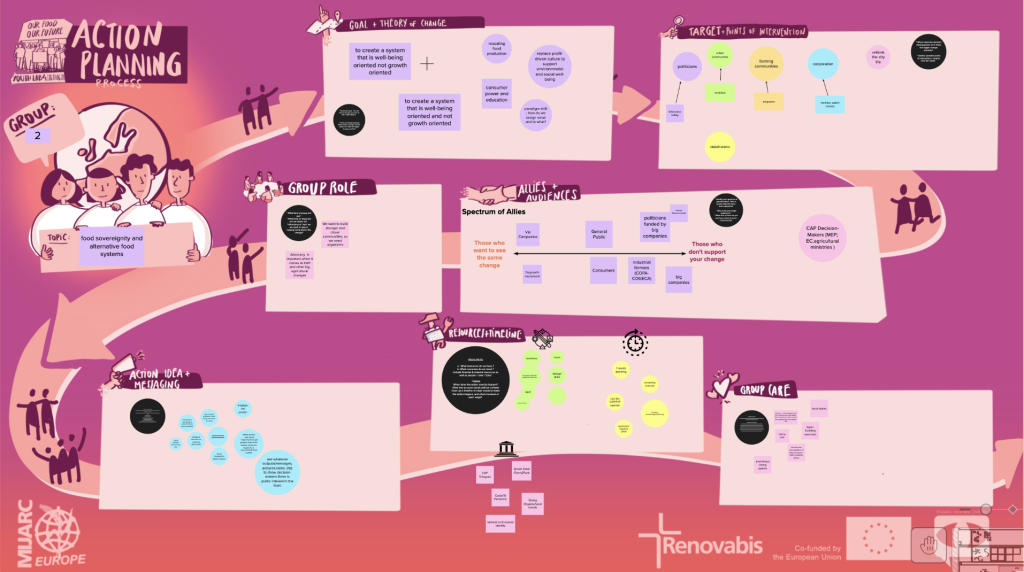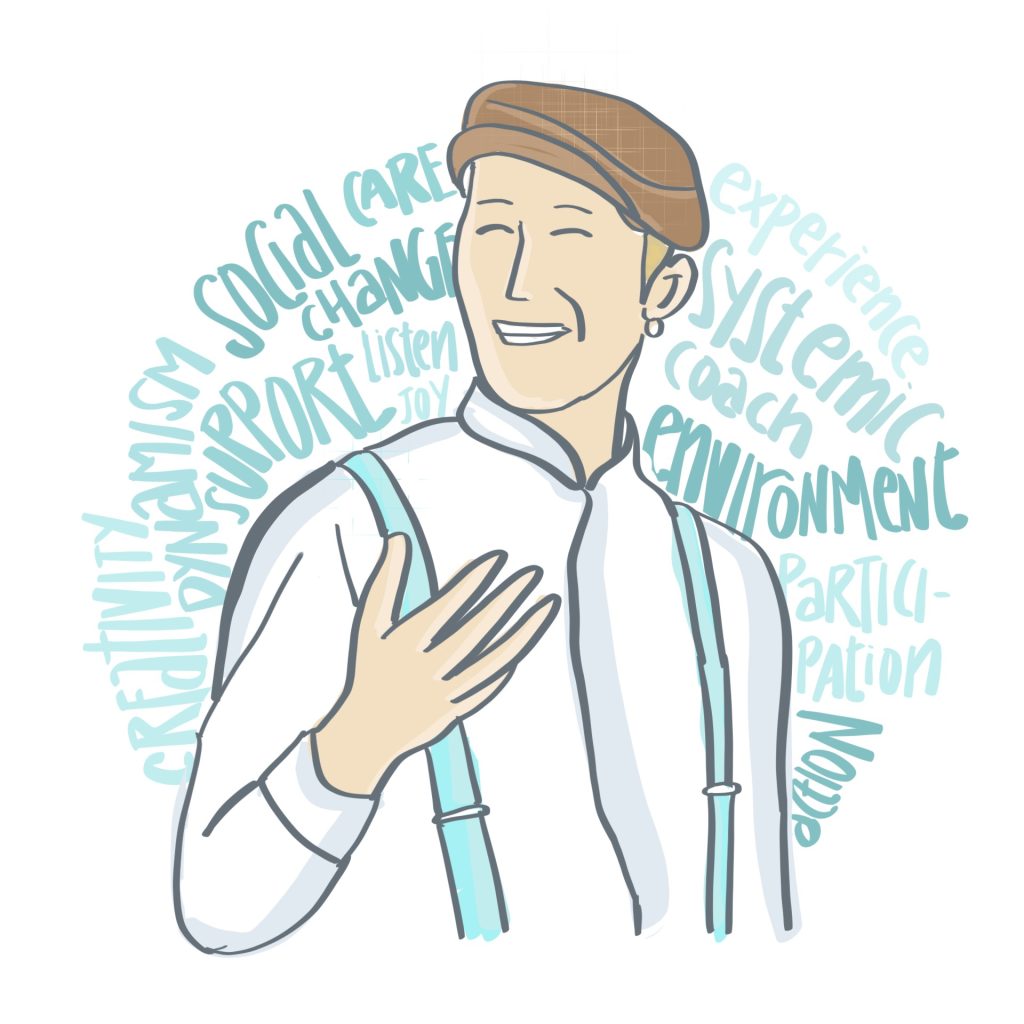
Graphic recorders* team up with facilitators and it has become common that one of them is present during larger scale online and in-person events and visualises what is said and done. The problem: All too often, the potential of their work is underused since only the outcome, the final images are what it is shown and applauded shortly in the end of the event. And then it all ends up in the report of the event or as decoration for the organisers´ head office meeting room or kitchen…
5 steps how you can unlock the potential of graphic recorders in your event
Together with Alejandro Gil (a graphic recorder with whom I love to collaborate with) we share some ideas with you that have supported our clients to get the most out of this powerful tool. Further down, you can read sone examples how visual facilitation/graphic recording has supported and enhanced workshops and projects. But here come our first 5 steps to unlock the full potential of graphic recording:
- An image worth one thousand words: Graphic recording is a craftsmanship that could boost your facilitation methodology and activities apart from creating a visual memory of your facilitation process. Preparing and creating a visual journey, a visual identity and a tailored visual library (icons, connectors, containers…) ahead of your facilitation process will help you to give consistency to your material and help the participants to better remember the process.
- The graphic recorder external voice can help your process: Create space and meaning for the graphic recorders view of the process, i.e. giving intermediary feedback and observation to the group. Allow and invite direct communication between the graphic recorder, facilitators and the participants. Get the most out of the graphic recorder presence (and the graphic recording) by coming back to the visual anytime you need to wrap up a session, to point out a key message, to boost the debate, to give a “push” to the participation in the process, to highlight contradictions or agreements and even more, make participants to draw their ideas when it is needed on the visual. Remember, more than individual practice, graphic recording is a collaborative process.
- Graphic recorders are more than artists: Graphic recorders are in most cases experienced professionals with a rich background in other fields such as facilitation, participatory processes, team management and more! When employing a graphic recorder, think more of a facilitator/process expert rather than an “photographer” or an “artist”. Get to know your partner and tap into their credentials and experience to make the most of your collaboration. Confirm correct terminology with the graphic recorder and model it so that your client/participants see them for what it is, both a product, a process and a thinking tool.
- The outcome of a graphic recording is more than a drawing: We encourage you to include the graphic recording in the full cycle of the project from the beginning until the day of the event, facilitation or training. Make time for the graphic recorder to participate in the clients meetings so they can see their value in the facilitation process. Blocking time and adding extra budget in your project planning is key.
Graphic recording and online events
And as now in the pandemic, many events go online/virtual, this creates another strong argument for graphic recording. Online meetings are by nature more visual, and as it tends to be hard for participants to stay focussed or engaged, graphic recording can make a big difference. Virtual whiteboards like Mural or Miro, with their features to add images and icons fast, are an own way of DIY graphic recording.

It can be even better if both team up: Working together on virtual whiteboards that include a visual structure pre-made by the graphic recorder, maybe thematic journeys or live-drawn content. Thereby we create a motivating framework and a common language for the event. The pro graphic recording will then during the event mainly be used for the overall storyline, and impromptu-visualisation is done by all in the team who document work visually on the whiteboard, see this example:
Online participant journey
For example, in an online activist/advocacy training process for the International Movement of Catholic Agricultural and Rural Youth (MIJARC Europe) in which we worked together in 2021, we developed this template to map out the discussion of the participants in their journey to organise an action:

Citizen Town Planning
In another project I was allowed to contribute as facilitator, the city administration of the double-city of Frankfurt-Oder/Slubice on the border of Germany and Poland invited citizens from both sides of the border river for a “Future Workshop” on how they want to live together in the next twenty years, how the city could change regarding architecture and city planning, but also activities and services. The whole process was co-created and visualised ahead from graphic facilitators, who prepared cartoon city maps on which visualised ideas could immediately be pinned and then moved around. Afterwards, the most interesting ideas were transferred physically to a timeline and some energy was spent to imagine the practical process of realization. Without the graphic recorders, it would have been so much less engaging to talk about the future of your own city. Seeing ideas take form was a great way to enhance exchange, ease decision processes and free creativity.


Visual facilitation in presence
I have also asked Alejandro Gil what were his best experiences of including graphic recording in events and facilitation processes? This is what he answered:
“Visual facilitation tools for online and in-person meetings helps the facilitator to boost discussions, create alignment and easily understand and remember the outcomes. One example of putting these tools into action was the final meeting of the coLAB project*, This project goal was to put a solution for the high rates of unemployment among qualified refugees. The project aimed to remedy this by hiring refugees as “visiting experts” who can share their knowledge with students and teaching staff, within the frame of the academic curriculum. Together with Otherwhere solutions we designed a full-day facilitation of the final meeting. Among other tools, we co-created all the visuals and templates that we used during the workshop and we put them together in a visual wall that helped people see the result of all the workshops. On the other hand, I co-facilitated the “evaluation workshop” in which teachers, members of the coordination team and refugees, got together to discussed the main barriers that they found during the project and the solutions to overcame them. Here you can see some photos of the process”
*Graphic recording is a visual practice where the practitioner (graphic recorder), maps out group processes and discussion content using visual metaphors (images, drawings…) and words, establishing connections within content, aids with insight, and supporting decision-making while people talk and see the information unfolding visually in front of their eyes. It is essentially a language that weaves words and pictures to facilitate group learning and cultural memory.
**implemented within the framework of the European Union/Council of Europe joint programme “Democratic and Inclusive School Culture in Operation1” (DISCO).
Want to get Visual?
Feel free to contact us and find out how visual facilitation could change your next online or analog event.

